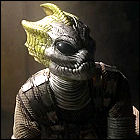 The Doctor tries yet again to take Rory and Amy on a romantic getaway, but instead of Rio, the TARDIS lands in Wales in 2020, near the site of a project to drill deep through the Earth’s crust. One man has already vanished without a trace from the small drilling operation, and other strange things are happening as well, such as patches of blue grass appearing on the surface. The rig’s owners hope this is a sign of a promising subsurface mineral deposit, but the Doctor can immediately tell it’s something else. When Amy disappears, his suspicions are confirmed: the drill has awakened the Silurians, the bipedal reptiles who roamed Earth before the ascent of humankind… and they’re more than wiling to take hostages to announce their presence prior to reclaiming their world. The Doctor and Nasreen Chaudrhy, the project’s chief researcher, go underground in the TARDIS to recover Amy and the other hostages, while the one Silurian that the Doctor and Rory can capture has plans of her own. Unlike the Doctor’s plan, her strategy doesn’t involve the human race’s better nature.
The Doctor tries yet again to take Rory and Amy on a romantic getaway, but instead of Rio, the TARDIS lands in Wales in 2020, near the site of a project to drill deep through the Earth’s crust. One man has already vanished without a trace from the small drilling operation, and other strange things are happening as well, such as patches of blue grass appearing on the surface. The rig’s owners hope this is a sign of a promising subsurface mineral deposit, but the Doctor can immediately tell it’s something else. When Amy disappears, his suspicions are confirmed: the drill has awakened the Silurians, the bipedal reptiles who roamed Earth before the ascent of humankind… and they’re more than wiling to take hostages to announce their presence prior to reclaiming their world. The Doctor and Nasreen Chaudrhy, the project’s chief researcher, go underground in the TARDIS to recover Amy and the other hostages, while the one Silurian that the Doctor and Rory can capture has plans of her own. Unlike the Doctor’s plan, her strategy doesn’t involve the human race’s better nature.
written by Chris Chibnall
directed by Ashley Way
music by Murray GoldCast: Matt Smith (The Doctor), Karen Gillan (Amy Pond), Arthur Darvill (Rory), Neve McIntosh (Alaya), Meera Syal (Nasreen Chaudhry), Robert Pugh (Tony Mack), Nia Roberts (Ambrose), Alun Rglan (Mo), Samuel Davies (Elliot)
Notes: This isn’t the first time that the Doctor has stumbled across industrial activity in Wales that uncovered something nasty: the third Doctor had to shut down Global Chemicals’ operation in 1973’s The Green Death; that incarnation of the Doctor also encountered the Silurians in Doctor Who and the Silurians (1970) and their aquatic relatives in 1972’s The Sea Devils.
LogBook entry & review by Earl Green
Review: Long overdue for a return to the Doctor Who universe (numerous book and audio appearances notwithstanding), the Silurians are one of the most intelligently-concocted antagonists of the original series – mainly because they weren’t really villains. The Silurians are the original owners of Earth, and according to the mythology established in their first appearance, they took to underground shelters to avoid a calamity that would soon befall the surface. Small pockets of  Silurian civilization have awoken from time to time as human activity triggered their automatic defenses, never in enough numbers to declare full-scale war (and, consequently, never in enough numbers to break BBC bosses out in a cold sweat by requiring an army’s worth of rubbery lizard suits). But on a purely conceptual level, the Silurians allow the show to address thorny topics such as the displacement of native cultures without invoking history and politics that the younger portion of the audience may know nothing about. Devised by Malcolm Hulke for their first appearance 40 years before The Hungry Earth aired, the Silurians are, in a word, characters with an Earthly agenda.
Silurian civilization have awoken from time to time as human activity triggered their automatic defenses, never in enough numbers to declare full-scale war (and, consequently, never in enough numbers to break BBC bosses out in a cold sweat by requiring an army’s worth of rubbery lizard suits). But on a purely conceptual level, the Silurians allow the show to address thorny topics such as the displacement of native cultures without invoking history and politics that the younger portion of the audience may know nothing about. Devised by Malcolm Hulke for their first appearance 40 years before The Hungry Earth aired, the Silurians are, in a word, characters with an Earthly agenda.
And it’s that 1970 debut, Doctor Who And The Silurians (which also happens to be one of this reviewer’s all-time favorite Doctor Who television adventures), that The Hungry Earth evokes the most, with barely-glimpsed creatures skulking in the shadows, slowly chipping away at a small cast of human characters, and hatching schemes to reclaim the Earth. With its mad plan (on the part of the humans, naturally) to drill miles into the Earth’s crust, there’s also more than a slight nod toward the other shining gem of season 7, Inferno (another high point of Pertwee’s era) – not a bad couple of stories to remind us of. But The Hungry Earth adds a delicious twist: the Silurians are counting on the psychology of the “apes” to guarantee a martyrdom which will lead to a war. There’s an opportunity here for Rory to shine, showing some increased maturity after traveling in the Doctor’s company, but not much is made of that.
I also have to admit to not being that impressed with the redesigned Silurians. I can accept the explanation that there are many tribes/subspecies in existence; even the New Adventures and Missing Adventures novels of the 1990s played with this idea, with one in particular, “Scales Of Injustice”, depicting a Silurian/Sea Devil hybrid in its cover artwork. But the new series Silurians diverge a little too much from what’s come before. The returning enemies in the Davies era – Daleks, Cybermen, Sontarans – all had significant nods to the previous designs; not so much here. There’s a vague similarity in the Silurians’ head crests, the fishnet-like outer layer of their costumes are a vague homage to the Sea Devils’ fishnet smocks, and their weapons also hearken back to the Sea Devil weapons from both The Sea Devils and Warriors Of The Deep. But in the end, the new Silurians look altogether too human. Unless there’s a story reason for that, I find the result a little less than pleasing. The original 1970 Silurians were unnervingly non-human (though the redesign for 1984’s Warriors Of The Deep managed to botch that design; the 2010 models look like, in all honesty, something from Star Trek: Voyager… or, worse yet, when they don their strange masks, they look like Sleestaks.
Whatever my issues are with the Silurians, however, they’re offset by a great cast of supporting human characters, with Meera Syal in particular raising the notion that it might be really interesting,  sometime down the road, for Matt Smith’s Doctor to be accompanied by a companion who’s obviously older than the Doctor seems to be. To some extent, this has been done in the Big Finish audio stories with the sixth Doctor and Evelyn Smythe, but the age divide could be even more significant with the eleventh Doctor.
sometime down the road, for Matt Smith’s Doctor to be accompanied by a companion who’s obviously older than the Doctor seems to be. To some extent, this has been done in the Big Finish audio stories with the sixth Doctor and Evelyn Smythe, but the age divide could be even more significant with the eleventh Doctor.

